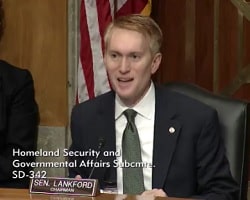Senate Gazes at Regulatory Dark Matter

 The Senate Subcommittee on Regulatory Affairs and Federal Management held a hearing yesterday, Examining the Use of Agency Regulatory Guidance, Part II, featuring testimony from CEI’s Wayne Crews; Paul R. Noe, vice president at American Forest & Paper Association and American Wood Council; and Amit Narang, a regulatory policy advocate. Presiding over the subcommittee was Sen. James Lankford (R-OK) and Sen. Heidi Heitkamp (D-ND).
The Senate Subcommittee on Regulatory Affairs and Federal Management held a hearing yesterday, Examining the Use of Agency Regulatory Guidance, Part II, featuring testimony from CEI’s Wayne Crews; Paul R. Noe, vice president at American Forest & Paper Association and American Wood Council; and Amit Narang, a regulatory policy advocate. Presiding over the subcommittee was Sen. James Lankford (R-OK) and Sen. Heidi Heitkamp (D-ND).
Crews noted that agencies do the bulk of lawmaking. There were a few dozen new laws passed last year, but during the same time-span, over 3000 new regulations were issued.
But numerous government agencies issue not merely regulations, but an abundances of notices, guidance documents, memoranda, and the like. In this manner, unelected agencies can bypass the Administrative Procedure Act’s requirement for notice and comment.
Sen. Lankford remarked that the proliferation of difficult-to-find guidance in the current system is a “shoebox of regulations in a dark closet and nobody knows where the closet is.”
Senator Joni Ernst’s (R-IA) opening question asked Crews to clarify the situation of “Regulatory Dark Matter,” his term for the proliferation of memoranda and guidance. Crews notes in a recent commentary for Forbes that “delegation of legislative power from the elected to the unelected is at the root of many of these concerns.” In his Senate testimony, Crews cites a recent GPO study finding that many regulations become law without any public notice or comment. Lankford agreed that this leads to regulations and rules that have massive impact on society being implemented without public participation or appropriate due process.
Crews and Noe agreed that greater transparency within the regulatory space is necessary. Crews cited his previous work that evaluates accessibility of significant guidelines with economic effect greater than $100 million. He uncovered 580 significant documents providing guidance across a maze of websites of varying quality. Both senators agreed that the lack of a database where entrepreneurs, employees, and citizens can search for guidelines negatively affect commerce.
Narang presented the argument that added transparency would lead to a delayed regulatory process due to lack of resources. Lankford countered that the lack of resources is more of a problem for local business owners who are unable to accurately interpret the sheer amount of agency proclamations. He said he believes that “no-action letters” from different agencies providing a “safe harbor” of action do not sufficiently solve the “dark matter” problem managers and owners face.
The hearing concluded with some agreement. Agencies need to be more transparent on the guidance documents they issue. Businesses should have a clear understanding of the regulations they face. Sen. Lankford reaffirmed his subcommittee’s dedication to examine the regulatory guidance of federal agencies and take the testimony into account when drafting legislation on regulatory dark matter.